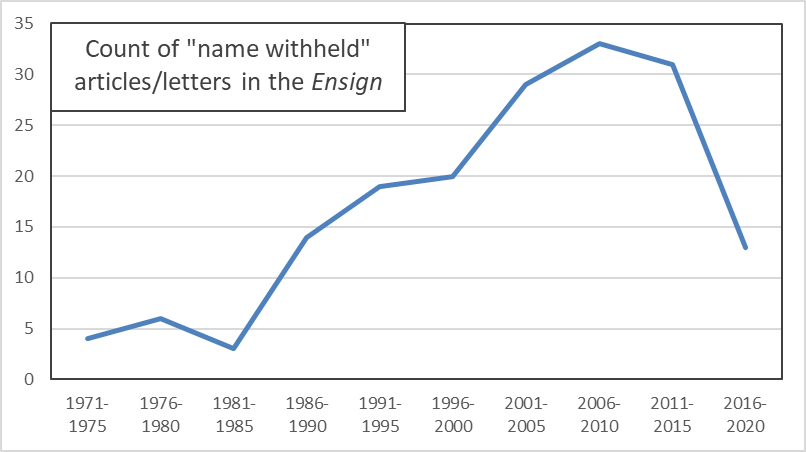A few years ago while reading the Ensign, I got to wondering about the reasons an article writer’s name is withheld. For an individual article, it’s typically pretty easy to guess, but I was wondering about larger trends. Even just cataloging the list of reasons seemed possibly interesting, because it’s a list of things that are considered shameful, but not too shameful. For example, a relatively large number of name withheld articles talk about divorce, but none that I’ve ever read talk about, say, bestiality. The articles provide a kind of list of troubling issues that are on writers’ (and editors’ and perhaps GAs’) minds. Also, while I was at it, I thought it would be fun to look at any trends across time and gender differences and a couple of other things.
I initially planned to look at all magazines on the Church website since 1971, but looking at the Ensign alone turned out to be fairly time-consuming, so I didn’t go any further. Maybe I’ll go back and look at the others another time. I found 172 articles and letters to the editor, using the search “‘name withheld’ site:churchofjesuschrist.org/study/ensign”. (To be precise, a few weren’t labeled exactly “name withheld.” I manually checked all the letters to the editor from the 1970s, after I found their authorship was occasionally noted as “A regular reader” or something similar.)
For each of the 172 documents, I noted the following:
- Publication year
- Gender of the writer (I was able to figure this out for 121 of the 172, or 70%)
- Is the name withheld because of something about the writer or something about another person?
- Is the person the actor (e.g., used porn) or the victim (e.g., was abused) in the situation?
- One or more reasons for the name to be withheld. (The max for any one document was four. Most documents had one. Three documents had zero, as I couldn’t figure out any reason at all.) I grouped these into 17 different categories, which I’ll list below with results.
- The story end type. I classified these into three different categories: perfect (where people end up married in the temple or going on missions), good (where things end up better than they started), and learned (where things don’t get better, but the writer learns to better accept them). I also assigned some documents a not applicable here when there was no story arc. This was the case for a fair number of the letters to the editor, where writers with name withheld often say no more than “I suffer from the same problem as the person in such-and-such an article.”
- How much the need to forgive the wrongdoer is discussed. I rated this as high, low (little discussion, or just reference to need to overcome bitterness and anger), or none.
I also tried noting down some other things, like the approximate age of the writer (typically difficult to figure out) or the location (rarely mentioned), but I wasn’t able to get enough useful data for them.
This graph shows the total number of documents in five-year periods across the history of the Ensign. Note that there’s no adjustment for possible differences in length of the magazine at different points in time.

Even with my extra combing through the 1970s issues, the prevalence of “name withheld” documents really didn’t take off until the latter half of the 1980s. It’s also interesting that it has dropped so dramatically in the latter part of the 2010s. I wonder if this is a change Russell M. Nelson has made, because even the 13 in the 2016-2020 period can be broken down into six in 2016 and seven total in the four following years.

